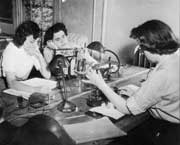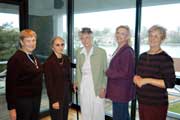|
|
 |
||||
|
Volume 13, Issue 19 ~ May12 - 18 2005
|
|||||
A half century ago, women integrated St. John’s College By Erica Naone When Melissa Skoog walks across the stage to graduate from St. John’s College May 15, she’ll carry not only her own memories but also the memories of five pioneers who opened her way. They are among the first women who studied at St. John’s, and Skoog and her friends Erin Hughey-Comers and Samantha Buker spent most of the past year trying to get them back. Last year, the three college seniors discovered the class of 2005 is the 50th St. John’s class to include women. They wanted to meet the women of 1955 — the first class of women — to share meals and talk and to find out what it was like to be a pioneering woman at an all-male school. On April 22, Skoog got her wish. She led Barbara Kiebler, Emily Kutler and Cornelia Reese as they pressed into the campus dining hall with the 11:30am rush of students leaving class for lunch. Kiebler and Kutler are two of two dozen women in the class of 1955. Reese followed them in the class of 1957, as a freshman when the last all-male class was graduating. Kutler and Kiebler had visited a language class the night before, listening to Skoog’s class wrestle with “Parker’s Back.” That 1965 short story by Southern writer Flannery O’Connor is one of only three works by women now on the 100-book required reading list at St. John’s. “That story wasn’t on the program when I was at St. John’s, because it hadn’t been written yet,” Kiebler laughed. When she and her sisters came to college, they read Jane Austen’s 1813 Pride and Prejudice, just elected as the only book by a woman the 68 Johnnies of that era would read. Barbara Leonard, the first female faculty member at the college, had been hired that same year as dean of women. At lunch half a century later, the three golden Johnnies traded memories and life stories with each other and with women from the current class. Kutler married Sam Kutler from the class just ahead of her, and the couple lived in Annapolis when he went on to teach at St. John’s. Kiebler is now a retired lawyer, settled in Hilton Head, South Carolina. Reese, a retired math teacher, lives in Westminster. Later that April day, Sarah Crooke from the class of 1955 joined her classmates, along with Charlotte Fletcher, who was college librarian when the women first came. The pioneers, some female staff and faculty and 10 modern-day female students shared an elegant dinner in the boathouse on campus overlooking College Creek. Changing Times “How did women first get into St. John’s?” Amy Taylor, a senior, asked. Part of the answer could be dimly pictured from where they sat. The view — which now looks onto the new dorm, Gilliam Hall, and an overflow parking lot — used to look out on a set of Quonset huts for married students. World War II veterans who came to St. John’s in the 1940s on the GI bill often lived in those Quonset huts with their families. By 1951, when the first women came to college, the flow of veterans had slowed. A small college, St. John’s needed more students. Barbara Goyette, now vice president for development at St. John’s and a graduate of the class of 1973, said administrators started thinking about the other people living in those Quonset huts, the women, who also wanted an education. Richard Weigle, college president at the time, pushed to let women come to college, both because the school needed the increased numbers and because he believed women had the right to higher education. St. John’s had just desegregated. Martin Dyer, the first black student to attend St. John’s, had arrived in 1948. It was a time of social change. Oberlin College in Ohio, a very liberal school, was the first college to go coed. They had been teaching women since the 1830s; Barbara Leonard had taught there before coming to St. John’s as dean of women. Many colleges waited more than 100 years to follow Oberlin’s lead, with Princeton and Yale remaining closed to women until 1969. Kiebler and her classmates, however, came to St. John’s caring more about learning than about social change. Eager to Learn Reese, who ended up teaching math partly because she wasn’t afraid of it, said her high school teachers rarely had patience with her curiosity. They told her, That’s a very good question, and I’m sure you realize why we don’t have time to answer it. At St. John’s, she saw that “part of the learning process was the questions and answers for both the students and faculty.” She fell in love with the school. “I felt like all my eagerness had a place to go, and a way to get there,” Reese said. Kiebler, who came to St. John’s thanks to a senatorial scholarship, hunted around for schools without fixing on one herself. It was her father who encouraged her to apply to St. John’s because of the high-quality education he believed she could get there. Other men were not as eager as Kiebler’s father for women to go to college. “The men were unsure socially about how it would change the campus,” Goyette said. “They were unsure that the women could do the work. All of that changed very quickly once the women came.”
Current Harvard President Lawrence Summers is not the first man to wonder if women have the same ability for math and science as men. The first women at St. John’s faced doubts about their ability to handle math, science and rigorous philosophical thinking. Students in the classes before them protested the “distraction” women would bring. Kiebler said she and her classmates were “on display” when they got to college. The group of them walked through a gauntlet of men everywhere they went. “The fact that there were not women in other classes did not seem to bother us very much,” said Carolyn Leeuwenburgh, a pioneer woman who was not able to attend the event. “What bothered us was how the men treated us.” At one of her end-of-semester evaluations, Leeuwenburgh said, a faculty member laughed at her opinions, saying, You should make babies. “Some men believed women were not capable of philosophical thinking,” Leeuwenburgh said. Math was the proving ground for several of these pioneers. Reese said that in her classes, men sometimes went out of their way to challenge women who got up to do math in front of the class. She chalked this up to “lack of maturity,” saying she did not get similar treatment from the upperclassmen. Geometry “came alive” for Reese at St. John’s. Kiebler also discovered her love of math while at the college, going on to study graduate mathematics after she finished her undergraduate degree. Their talents had an effect. John Oosterhout, the man Kiebler married after sophomore year, “was one of the leaders of the student protest against admitting women,” Kiebler remembered. “But he changed his mind.” Over time, women gained acceptance, though doubts lingered. Even in the ’70s, Goyette said, when she was at St. John’s, women’s opinions “were not taken as seriously” as men’s. “Women did the work, especially in tutorials. They had always done the translations, were prepared for class, did demonstrations — and didn’t always get recognition for contributing to the flow of the classroom in that way,” she said. When Goyette returned to St. John’s in 1994 as staff, she said she was glad to find a strong female presence in classes, with many women recognized as campus leaders. “I thought, ‘These girls are so awesome!’” she said. Even more has changed for Skoog in today’s classes. “I think being at St. John’s must somehow be different for a woman than it is for a man, but I think it is different in the way that being in the world is different for men and women,” Skoog said. Holding What They Learned Leeuwenburgh got a contract to sing at a European opera house, and left college before she graduated. She carried her education with her, even without a degree. When critics praised her understanding of her singing roles, she said, what they praised was her understanding of librettos, which came from her time at the college. “If you’ve balanced and thought and read and understood,” Leeuwenburgh said, “your idea’s just as good as the next guy’s.” Kiebler went on to have four children, take graduate courses in mathematics and earn a law degree in her 40s. She said she knew she could go to law school because she had made it through St. John’s. “I have an undying conviction that if I sit down and work at it,” she said, “I can learn anything.” Like Leeuwenburgh, Kutler left before finishing her undergraduate degree. She later returned to earn a master’s from the St. John’s Graduate Institute. Most of all, St. John’s first women were persistent and flexible. As a teacher herself, Reese got a reputation for her willingness to work with students until they understood. When one class had trouble with ratios, Reese took them on a field trip. Setting textbooks aside, she and her class trooped outside and measured the shadows of the school buildings. She taught them to set up ratios and find the heights of the buildings. Bringing Inspiration Skoog stood up at dinner to give a short speech thanking the women who came before her for their legacy and inspiration. Skoog is no stranger to leaving a legacy; this year, she led her class’s gift committee. She and her classmates are working to make copies of the senior non-Euclidean geometry text free for all students who come after them. Skoog worked with school officials to set up an endowed fund to make this happen. Even in this project, Skoog was inspired by the pioneer women. She, Buker and Hughey-Comers made a calendar honoring 50 years of women at St. John’s. Buker photographed current students, and the three friends placed them in the calendar along with archive photos of the original women. Money from calendar sales will go toward the gift fund. “It was wonderful to see that the women from 1955 have carried what they have studied at St. John’s with them,” Skoog said. “They’ve been thinking about ideas ever since they started here, and they were still passionate about them 50 years later. That’s exactly what I hope to accomplish in the next 50 years.” About the Author Erika Naone graduates from St. John’s on May 15. During a two-year break from college, she reported for the DeLand-Deltona (Florida) Beacon. This is her first story for Bay Weekly. |
|||||
|
© COPYRIGHT 2004 by New Bay Enterprises, Inc. All rights reserved. |

